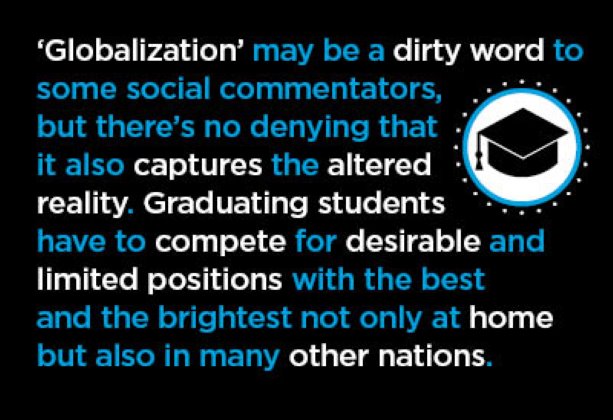When I first began to consider changing trends in the construction of educational facilities and what the implications might be for design professionals and building product manufacturers, I struggled with establishing a proper vantage point.
Then a particularly helpful notion struck me. Why not ask what each of the principal stakeholders in the learning process wants to achieve?
An appraisal of how to deliver those results would surely serve as a guidepost to where opportunities lie for contractors and material providers.
The four notable constituents are analyzed one-by-one in the sections that follow. By no means are the desires of one group exclusive to it alone. There are multiple instances of overlap.
What do students want? Some students may still be of the party-hearty, learn things at the last minute, variety. But the world has changed fundamentally from previous generations to this one, so that many others are taking the learning experience far more seriously.
They know that when they leave school, they’ll be immersed in what has become an integrated world-wide job market.
‘Globalization’ may be a dirty word to some social commentators, but there’s no denying that it also captures the altered reality. There are now fewer and fewer employment opportunities for which the work cannot be outsourced to a backroom in some far-off locale.
Graduating students have to compete for desirable and limited positions with the best and the brightest not only at home but also in many other nations.
Furthermore, students from other countries are increasingly in attendance at U.S. and Canadian universities and colleges. All on its own, the more varied ethnic make-up of enrolments is changing the way children and young adults view their world. They know they’re part of a vastly extended community.
This is not as jarring a proposition for them as it may be for their parents. Many of the students of today are already well-traveled, to a degree an older generation would never have imagined.
I’m always amazed at how the friends of my children and their families simply pick up and go abroad, during summer vacations and indeed throughout the year, either as tourists or to visit relatives ‘back home’.
Or even if not frequently in transit, today’s young people have established friendships with their peers elsewhere through interactions on Facebook or Twitter or some other social media means.
Able to text rapid-fire − with their thumbs, no less − and to carry on multiple virtual conversations while simultaneously surfing the web on their mobile devices, they can’t stand being bored. For them, even watching television is an exercise in multi-taking, as they play digital games on the side.
They may have a deep desire for formal learning, but the challenge for teachers to find ways to first tweak and then hold their attention has been magnified. This is where electronic games makers and the purchasing departments of boards of education can find common ground.
What do parents want? Some parents simply want their kids to finish school and enter the workforce. They’ve become frustrated by an offspring who, dissatisfied with his or her specialty, is continuing on with a second or ‘please say it isn’t so’ third degree. (If it’s a case of working towards a Master’s degree or PhD, however, that’s a different matter. Elevate your nose slightly, stick out your chest and annoy everyone around you with boasting about your son or daughter.)
In the big scheme of things, though, those are minor quibbles. What parents truly want for their children is that they exit their academic years with the skills needed for a job that will provide not only good earnings, but also a rewarding life.
Let’s not gloss over how some schools are no longer ideal social milieus. One of the primary concerns for parents of students running the full gamut of ages is basic security. Electronic alarm-force companies are stepping in and reaping benefits.
In many instances, ensuring safety has led to unfortunate consequences – e.g., a proliferation of guards and weaponry. Better safe than sorry, though, has become the mantra of many.
There’s also a desire on the part of parents for crackdowns on unacceptable social behavior.
Instances of sexual assault that have come to light are being addressed more assertively.
‘Frat-boy’ and/or ‘jock’ culture is coming under increasing scrutiny. When exposed as rampant, those institutions still enabling such bad behavior are paying a heavy price in terms of loss of prestige.
What do educators want? The new buzzwords among educators mostly start with the letter ‘c’. They are ‘community’, ‘collaboration’ and ‘cooperation’, with social ‘conscience’ as an important ingredient in the mix as well.
Students are being encouraged to work more closely together than in the past. The belief is that side-by-side partnerships unleash creative energies exponentially. The inspirational model comes from the rapid advances being achieved in the post-academic, knowledge-based segment of the economy.
New school designs are eliminating big lecture halls in favor of smaller gathering spots where professors mingle with their ‘disciples’ and where broader discourse is widely encourage.
Walls and hallways are being eliminated in order to encourage more intellectual interaction.
And if it’s moving outside the classroom you want, then recognize that being physically present on a campus site is no longer a necessity. A plethora of courses and degree programs is being offered on-line, often enhanced by the lecture notes and commentary of top teachers.
The ‘bricks and mortar’ versus Internet investment debate has migrated from the retail sector as far as campus quadrangles, to the detriment of designers and contractors.
As for other goals of educators, closer approaches to gender parity in some subject areas ranks high on their list.
What do employers want? Some want good students they can mold. Others want students who, once hired, can hit the ground running.
Perhaps the greatest potential for private and public sector (e.g., departments of agriculture) employers venturing into the world of academia, however, lies in joint venture research projects. Many of the new structures being built at colleges and universities owe their existence to funding from firms looking for the next wave in product development.
This cash source, along with generous donations or endowments from alumni who have struck it rich in the business world, has become a key solution for academic institutions looking for the means to expand their footprint.
Employers also highly value the opportunity to send some of their workers back to school for further training. The fact high-tech firms recognize the importance of ongoing study is evident from the manner in which their workplaces are also often referred to as campuses.
Hiccups along the way? As for any other trends on campus worthy of mention, student bodies may soon be comprised of an older demographic. Retiring baby boomers are returning to classrooms to study for degrees in subject areas for which they have a particular passion (e.g., music appreciation).
For some of those older citizens, they have the time and the money to fulfill long-held dreams.
But this might lead to a hiccup or two. The courses they’ll be taking, combined with their stage in life, won’t likely be advancing a career agenda. Hopefully, this won’t lead to scarce resources becoming inadvertently side-tracked.











Recent Comments
comments for this post are closed